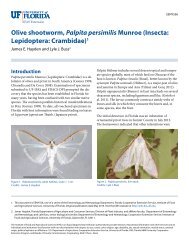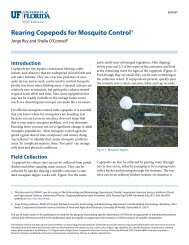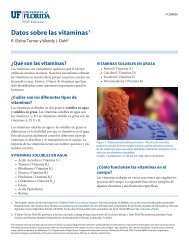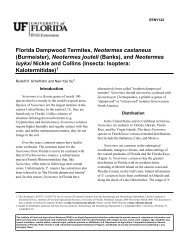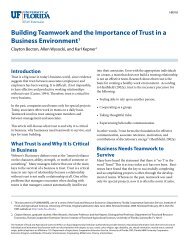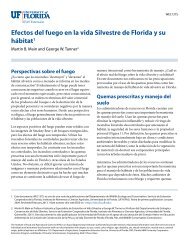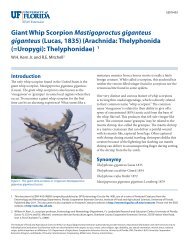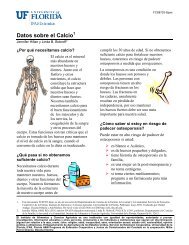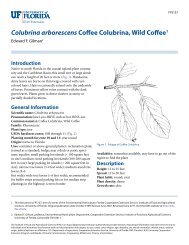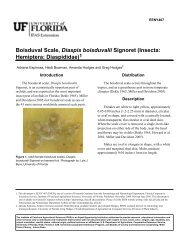Use of Hydrogen Peroxide in Finfish Aquaculture1 - EDIS ...
Use of Hydrogen Peroxide in Finfish Aquaculture1 - EDIS ...
Use of Hydrogen Peroxide in Finfish Aquaculture1 - EDIS ...
Create successful ePaper yourself
Turn your PDF publications into a flip-book with our unique Google optimized e-Paper software.
FA157<br />
<strong>Use</strong> <strong>of</strong> <strong>Hydrogen</strong> <strong>Peroxide</strong> <strong>in</strong> F<strong>in</strong>fish Aquaculture 1<br />
Roy P. E. Yanong 2<br />
Introduction<br />
<strong>Hydrogen</strong> peroxide is commonly used as a<br />
dis<strong>in</strong>fectant for clean<strong>in</strong>g wounds <strong>in</strong> people. <strong>Hydrogen</strong><br />
peroxide has also been used <strong>in</strong> aquaculture as an<br />
immersion (bath) treatment aga<strong>in</strong>st many different<br />
disease-caus<strong>in</strong>g organisms, <strong>in</strong>clud<strong>in</strong>g external<br />
parasites, bacteria, and fungi, on different species and<br />
life-stages <strong>of</strong> fish. The U.S. Food and Drug<br />
Adm<strong>in</strong>istration (FDA) recently approved a<br />
hydrogen-peroxide-based aquaculture product, which<br />
has spurred greater <strong>in</strong>terest <strong>in</strong> its use.<br />
What is hydrogen peroxide?<br />
<strong>Hydrogen</strong> peroxide is the chemical compound<br />
H 2<br />
O 2<br />
. <strong>Hydrogen</strong> peroxide is a highly reactive, strong<br />
oxidiz<strong>in</strong>g and bleach<strong>in</strong>g (whiten<strong>in</strong>g) agent that is<br />
classified as corrosive at concentrations higher than<br />
20%. <strong>Hydrogen</strong> peroxide has numerous non-medical<br />
and medical uses because <strong>of</strong> these properties. When<br />
added to water, hydrogen peroxide breaks down <strong>in</strong>to<br />
oxygen and water over time, and the formation <strong>of</strong><br />
these by-products is one reason that hydrogen<br />
peroxide is considered to be relatively safe for the<br />
environment. <strong>Hydrogen</strong> peroxide's highly reactive<br />
nature, similar <strong>in</strong> some respects to the reactivity <strong>of</strong><br />
potassium permanganate, makes it ideal for use <strong>in</strong><br />
aquaculture aga<strong>in</strong>st numerous external<br />
fish-disease-caus<strong>in</strong>g organisms, but with similar<br />
concerns regard<strong>in</strong>g toxicity. The FDA-approved<br />
product, 35% PEROX-AID® (Eka Chemicals,<br />
Marietta, Georgia), is available at a strength <strong>of</strong> 35%<br />
weight/weight (e.g., 35% active <strong>in</strong>gredient).<br />
Over-the-counter products used for human health are<br />
typically sold at 3% active <strong>in</strong>gredient.<br />
How stable is hydrogen peroxide <strong>in</strong><br />
water?<br />
A number <strong>of</strong> different elements, enzymes, and<br />
compounds, as well as light, heat, and high pH all<br />
accelerate the degradation <strong>of</strong> hydrogen peroxide. It is<br />
important to understand the stability <strong>of</strong> hydrogen<br />
peroxide <strong>in</strong> water because toxicity can result from<br />
improper use and excessive exposure.<br />
At 15°C (~59°F) and 20°C (~68°F), <strong>in</strong>itial<br />
hydrogen peroxide concentrations <strong>of</strong> 10 and 100<br />
mg/L <strong>in</strong> tank culture water were not measurable after<br />
2–3 days <strong>in</strong> the presence <strong>of</strong> aeration and/or organic<br />
matter. Under static water conditions with no aeration<br />
1. This document is FA157, one <strong>of</strong> a series <strong>of</strong> the program <strong>in</strong> Fisheries and Aquatic Sciences <strong>in</strong> the School <strong>of</strong> Forest Resources and Conservation, Florida<br />
Cooperative Extension Service, Institute <strong>of</strong> Food and Agricultural Sciences, University <strong>of</strong> Florida. Orig<strong>in</strong>al publication date December 2008. Revised June<br />
2011. Visit the <strong>EDIS</strong> website at http://edis.ifas.ufl.edu.<br />
2. Roy P.E. Yanong, associate pr<strong>of</strong>essor and extension veter<strong>in</strong>arian, Tropical Aquaculture Laboratory, Rusk<strong>in</strong> FL 33570, Program <strong>in</strong> Fisheries and Aquatic<br />
Sciences, School <strong>of</strong> Forest Resources and Conservation, Florida Cooperative Extension Service, Institute <strong>of</strong> Food and Agricultural Sciences, University <strong>of</strong><br />
Florida, Ga<strong>in</strong>esville, FL 32611.<br />
The Institute <strong>of</strong> Food and Agricultural Sciences (IFAS) is an Equal Opportunity Institution authorized to provide research, educational <strong>in</strong>formation and<br />
other services only to <strong>in</strong>dividuals and <strong>in</strong>stitutions that function with non-discrim<strong>in</strong>ation with respect to race, creed, color, religion, age, disability, sex,<br />
sexual orientation, marital status, national orig<strong>in</strong>, political op<strong>in</strong>ions or affiliations. U.S. Department <strong>of</strong> Agriculture, Cooperative Extension Service,<br />
University <strong>of</strong> Florida, IFAS, Florida A. & M. University Cooperative Extension Program, and Boards <strong>of</strong> County Commissioners Cooperat<strong>in</strong>g. Millie<br />
Ferrer-Chancy, Interim Dean
<strong>Use</strong> <strong>of</strong> <strong>Hydrogen</strong> <strong>Peroxide</strong> <strong>in</strong> F<strong>in</strong>fish Aquaculture 2<br />
or organic matter, concentrations were halved by day<br />
6 and undetectable by day 10 (Tort et al. 2003).<br />
Another study tested the stability <strong>of</strong> hydrogen<br />
peroxide dur<strong>in</strong>g tank trials with ornamental fish and<br />
<strong>in</strong> earthen ponds without fish (Russo et al. 2007). In<br />
the tank trials, groups <strong>of</strong> 17–25 fish were placed <strong>in</strong>to<br />
separate, static systems consist<strong>in</strong>g <strong>of</strong> a glass<br />
aquarium conta<strong>in</strong><strong>in</strong>g 32 liters (~8.5 gallons) <strong>of</strong> water<br />
and aeration. Beg<strong>in</strong>n<strong>in</strong>g concentrations <strong>of</strong> hydrogen<br />
peroxide ranged from 1.2–26.9 mg/L. The hydrogen<br />
peroxide concentration was tested 1 hour and 24<br />
hours after the <strong>in</strong>itial dose was added. After 1 hour,<br />
concentrations did not vary significantly from start<strong>in</strong>g<br />
concentrations <strong>in</strong> all tanks. However, after 24 hours,<br />
concentrations <strong>in</strong> all tanks had decreased to 0.4–0.8<br />
mg/L (Russo et al. 2007).<br />
In the same study, two earthen ponds with <strong>in</strong>itial<br />
hydrogen peroxide concentrations <strong>of</strong> 6.46 and 13.60<br />
mg/L, respectively, had concentrations <strong>of</strong> 1–2 mg/L<br />
after 24 hours (Russo et al. 2007).<br />
<strong>Hydrogen</strong> peroxide appears to degrade relatively<br />
rapidly <strong>in</strong> the presence <strong>of</strong> organic material and<br />
aeration; however, species sensitivities and start<strong>in</strong>g<br />
concentrations will also determ<strong>in</strong>e its toxicity to<br />
fish.<br />
Is hydrogen peroxide legal for use <strong>in</strong><br />
aquaculture?<br />
In 2007, 35% PEROX-AID® (Eka Chemicals,<br />
Marietta, Georgia) was approved by the FDA for<br />
control <strong>of</strong> mortality <strong>in</strong> (1) freshwater-reared f<strong>in</strong>fish<br />
eggs due to saprolegniasis (a common water mold),<br />
(2) freshwater-reared salmonids due to bacterial gill<br />
disease (Flavobacterium branchiophilum), and (3)<br />
freshwater-reared coolwater f<strong>in</strong>fish and channel<br />
catfish due to external columnaris (Flavobacterium<br />
columnare) disease. No other forms <strong>of</strong> hydrogen<br />
peroxide, <strong>in</strong>clud<strong>in</strong>g those sold for human use, are<br />
approved for use with fish.<br />
What quantities are available?<br />
35% PEROX-AID ® (35%) is currently<br />
available <strong>in</strong> 55-gallon drums.<br />
What are the approved dosage rates<br />
for 35% PEROX-AID ® use?<br />
Producers should test any treatment us<strong>in</strong>g<br />
hydrogen peroxide for safety and efficacy. Test on a<br />
small number <strong>of</strong> fish before treat<strong>in</strong>g the entire lot.<br />
A summary <strong>of</strong> the FDA-approved label dosage<br />
rates for hydrogen peroxide is located <strong>in</strong> Table 1.<br />
How do I calculate the volume <strong>of</strong><br />
hydrogen peroxide to add to my<br />
system?<br />
<strong>Use</strong> the follow<strong>in</strong>g formula to calculate how<br />
much 35% PEROX-AID® should be added to a<br />
system for treatment. NOTE: This formula will not<br />
work for hydrogen peroxide products that are not<br />
35% active <strong>in</strong>gredient. Furthermore, use <strong>of</strong><br />
non-approved products is illegal. Work with an<br />
aquatic veter<strong>in</strong>arian or other fish health specialist to<br />
make sure you are us<strong>in</strong>g 35% PEROX-AID<br />
properly.<br />
The follow<strong>in</strong>g formula can be used to determ<strong>in</strong>e<br />
the volume (<strong>in</strong> milliliters [= mL] <strong>of</strong> 35%<br />
PEROX-AID® required for a given treatment<br />
concentration and system volume.<br />
NOTE: There are 396,100 mg <strong>of</strong> hydrogen<br />
peroxide per L <strong>of</strong> 35% PEROX-AID®.<br />
NOTE: There are 1000 mL <strong>in</strong> 1 L. The liters are<br />
converted to milliliters to allow for easier measur<strong>in</strong>g<br />
<strong>of</strong> the 35% PEROX-AID® liquid for treatment.<br />
For example, if you need to use a treatment<br />
concentration <strong>of</strong> 500 mg/L and will treat 150 liters <strong>of</strong><br />
water <strong>in</strong> a closed system, then:<br />
Static or closed-system treatments are the most<br />
common aquaculture systems used <strong>in</strong> Florida. If you<br />
are treat<strong>in</strong>g a raceway type or any other type <strong>of</strong><br />
system, contact an aquatic veter<strong>in</strong>arian or other fish<br />
health specialist to determ<strong>in</strong>e proper dos<strong>in</strong>g<br />
protocol.
<strong>Use</strong> <strong>of</strong> <strong>Hydrogen</strong> <strong>Peroxide</strong> <strong>in</strong> F<strong>in</strong>fish Aquaculture 3<br />
Table 1. FDA-approved dosages for 35% PEROX-AID® (35% weight/weight hydrogen peroxide)<br />
Fish Species and<br />
Life Stage<br />
All<br />
freshwater-reared<br />
cold- and coolwater<br />
f<strong>in</strong>fish eggs<br />
All<br />
freshwater-reared<br />
warmwater f<strong>in</strong>fish<br />
eggs<br />
Freshwater-reared<br />
salmonids<br />
Freshwater-reared<br />
salmonids<br />
Freshwater-reared<br />
coolwater f<strong>in</strong>fish<br />
f<strong>in</strong>gerl<strong>in</strong>gs and adults<br />
Target Disease<br />
Organism<br />
Dosage Rate Duration Frequency<br />
Saprolegnia 500–1000 mg/L 15 m<strong>in</strong>utes Once per day or on<br />
alternate days until<br />
hatch<br />
Saprolegnia 750–1000 mg/L 15 m<strong>in</strong>utes Once per day or on<br />
alternate days until<br />
hatch<br />
Bacterial gill disease<br />
(Flavobacterium<br />
branchiophilum)<br />
Bacterial gill disease<br />
(Flavobacterium<br />
branchiophilum)<br />
Columnaris<br />
(Flavobacterium<br />
columnare)<br />
100 mg/L <strong>in</strong><br />
cont<strong>in</strong>uous flow or<br />
static bath<br />
50–100 mg/L <strong>in</strong><br />
cont<strong>in</strong>uous flow or<br />
static bath<br />
50–75 mg/L <strong>in</strong><br />
cont<strong>in</strong>uous flow or<br />
static bath<br />
30 m<strong>in</strong>utes Once every other day<br />
for three treatments<br />
60 m<strong>in</strong>utes Once every other day<br />
for three treatments<br />
60 m<strong>in</strong>utes Once every other day<br />
for three treatments<br />
Freshwater-reared<br />
coolwater f<strong>in</strong>fish fry<br />
Channel catfish<br />
f<strong>in</strong>gerl<strong>in</strong>gs and adults<br />
Channel catfish fry<br />
Columnaris<br />
(Flavobacterium<br />
columnare)<br />
Columnaris<br />
(Flavobacterium<br />
columnare)<br />
Columnaris<br />
(Flavobacterium<br />
columnare)<br />
50 mg/L <strong>in</strong> cont<strong>in</strong>uous<br />
flow or static bath<br />
50–75 mg/L <strong>in</strong><br />
cont<strong>in</strong>uous flow or<br />
static bath<br />
50 mg/L <strong>in</strong><br />
cont<strong>in</strong>uous flow or<br />
static bath<br />
60 m<strong>in</strong>utes Once every other day<br />
for three treatments<br />
60 m<strong>in</strong>utes Once every other day<br />
for three treatments<br />
60 m<strong>in</strong>utes Once every other day<br />
for three treatments<br />
Can hydrogen peroxide be used on<br />
other warmwater f<strong>in</strong>fish species<br />
<strong>in</strong>tended for human consumption<br />
and for other <strong>in</strong>dications not on the<br />
label?<br />
A veter<strong>in</strong>arian can prescribe 35% PEROX-AID®<br />
for an extralabel use provided that all the provisions<br />
<strong>in</strong> Title 21 Code <strong>of</strong> Federal Regulations Part 530 (21<br />
CFR 530)<br />
(<br />
http://www.accessdata.fda.gov/scripts/cdrh/cfdocs/<br />
cfcfr/CFRSearch.cfm?CFRPart=530) are followed.<br />
In brief, the client must be work<strong>in</strong>g with a<br />
veter<strong>in</strong>arian with<strong>in</strong> the context <strong>of</strong> a valid<br />
veter<strong>in</strong>arian-client-patient relationship (see<br />
description below), and there must be no residues that<br />
pose a public health risk. Research us<strong>in</strong>g food fish<br />
species is much more common <strong>in</strong> the literature, and<br />
biotests will most likely be required to determ<strong>in</strong>e the<br />
best dose and treatment time for specific disease<br />
problems. A summary <strong>of</strong> unapproved doses and<br />
<strong>in</strong>dications used by researchers <strong>in</strong> foodfish species is<br />
outl<strong>in</strong>ed <strong>in</strong> Table 2. As for approved uses and species,<br />
follow label <strong>in</strong>structions and contact the appropriate<br />
regulatory authorities regard<strong>in</strong>g discharge <strong>of</strong> treated<br />
water.<br />
21 CFR 530:<br />
A valid veter<strong>in</strong>arian-client-patient relationship<br />
is one <strong>in</strong> which:<br />
(1) A veter<strong>in</strong>arian has assumed the<br />
responsibility for mak<strong>in</strong>g medical judgments<br />
regard<strong>in</strong>g the health <strong>of</strong> (an) animal(s) and the<br />
need for medical treatment, and the client (the<br />
owner <strong>of</strong> the animal or animals or other<br />
caretaker) has agreed to follow the <strong>in</strong>structions<br />
<strong>of</strong> the veter<strong>in</strong>arian;
<strong>Use</strong> <strong>of</strong> <strong>Hydrogen</strong> <strong>Peroxide</strong> <strong>in</strong> F<strong>in</strong>fish Aquaculture 4<br />
(2) There is sufficient knowledge <strong>of</strong> the<br />
animal(s) by the veter<strong>in</strong>arian to <strong>in</strong>itiate at least<br />
a general or prelim<strong>in</strong>ary diagnosis <strong>of</strong> the<br />
medical condition <strong>of</strong> the animal(s); and<br />
(3) The practic<strong>in</strong>g veter<strong>in</strong>arian is readily<br />
available for follow-up <strong>in</strong> case <strong>of</strong> adverse<br />
reactions or failure <strong>of</strong> the regimen <strong>of</strong> therapy.<br />
Such a relationship can exist only when the<br />
veter<strong>in</strong>arian has recently seen and is<br />
personally acqua<strong>in</strong>ted with the keep<strong>in</strong>g and<br />
care <strong>of</strong> the animal(s) by virtue <strong>of</strong> exam<strong>in</strong>ation<br />
<strong>of</strong> the animal(s) and/or by medically<br />
appropriate and timely visits to the premises<br />
where the animal(s) are kept.<br />
cfcfr/CFRSearch.cfm?CFRPart=530) are followed.<br />
Producers should work closely with a veter<strong>in</strong>arian<br />
when consider<strong>in</strong>g use <strong>of</strong> any drugs.<br />
In freshwater ornamental aquaculture, husbandry<br />
practices <strong>of</strong>ten logistically favor use <strong>of</strong> lower doses<br />
<strong>of</strong> drugs for longer time periods. In one study (Russo<br />
et al. 2007), results suggested that use <strong>of</strong> 3.1 mg/L<br />
hydrogen peroxide for one hour may be effective for<br />
control <strong>of</strong> external bacteria, and use <strong>of</strong> 6.5 mg/L or<br />
more for one hour may be effective for control <strong>of</strong><br />
external flagellates, <strong>in</strong>clud<strong>in</strong>g the parasite<br />
Ichthyobodo sp., <strong>in</strong> swordtails (Xiphophorus hellerii).<br />
Trichod<strong>in</strong>a sp. and Gyrodactylus sp, however, did not<br />
appear to be controlled with this regimen. As for<br />
Table 2. Unapproved, experimental uses documented <strong>in</strong> <strong>in</strong>fected food fish species or for pathogen alone<br />
Fish Species and<br />
Life Stage<br />
Ra<strong>in</strong>bow trout<br />
Juveniles<br />
(Rach et al. 2000)<br />
Pacific threadf<strong>in</strong><br />
(Polydactylus<br />
sexfilis)<br />
juveniles<br />
Pacific threadf<strong>in</strong><br />
(Polydactylus<br />
sexfilis)<br />
juveniles<br />
No fish host<br />
K<strong>in</strong>gfish<br />
(Seriola lalandi)<br />
juveniles<br />
No fish host<br />
Target Disease<br />
Organism<br />
Ambiphrya<br />
(sessile ciliated<br />
protistan)<br />
Gyrodactylus<br />
(monogenean)<br />
Amylood<strong>in</strong>ium<br />
(d<strong>in</strong><strong>of</strong>lagellate)<br />
Amylood<strong>in</strong>ium<br />
(d<strong>in</strong><strong>of</strong>lagellate)<br />
Uronema<br />
(ciliated protistan)<br />
Zeuxapta seriolae<br />
(monogenean)<br />
Tenacibaculum<br />
maritimum<br />
(bacteria)<br />
Dosage Rate Duration Frequency Reference<br />
170, 280, or 560<br />
mg/L<br />
static bath<br />
75–100 mg/L<br />
lab tank trial<br />
static bath<br />
75 mg/L<br />
field tank trial<br />
250 or 500 mg/L<br />
static bath<br />
300 mg/L<br />
static bath<br />
30 m<strong>in</strong>utes Once<br />
Rach et al. 2000<br />
30 m<strong>in</strong>utes Once Montgomery-<br />
Brock et al. 2001<br />
30 m<strong>in</strong>utes Two treatments,<br />
six days apart<br />
Montgomery-<br />
Brock et al. 2001<br />
60 m<strong>in</strong>utes Once Crosbie and<br />
Munday 1999<br />
10 m<strong>in</strong>utes Once Mansell et al. 2005<br />
30–240 mg/L 30 m<strong>in</strong>utes Once Avendano-Herrera<br />
et al. 2006<br />
Can hydrogen peroxide be used <strong>in</strong><br />
ornamental f<strong>in</strong>fish species and for<br />
other <strong>in</strong>dications?<br />
approved uses and species, follow label <strong>in</strong>structions<br />
and contact the appropriate regulatory authorities<br />
regard<strong>in</strong>g discharge <strong>of</strong> treated water.<br />
A veter<strong>in</strong>arian can prescribe 35% PEROX-AID®<br />
for an extralabel use provided that all the provisions<br />
<strong>in</strong> Title 21 Code <strong>of</strong> Federal Regulations Part 530 (21<br />
CFR 530)<br />
(http://www.accessdata.fda.gov/scripts/cdrh/cfdocs/
<strong>Use</strong> <strong>of</strong> <strong>Hydrogen</strong> <strong>Peroxide</strong> <strong>in</strong> F<strong>in</strong>fish Aquaculture 5<br />
Are there any target animal safety<br />
concerns with use <strong>of</strong> hydrogen<br />
peroxide?<br />
As with any aquaculture drug or chemical,<br />
improper use may potentially lead to <strong>in</strong>effectiveness<br />
<strong>of</strong> treatment. Underdos<strong>in</strong>g, toxicity from overdos<strong>in</strong>g,<br />
and pathogen tolerance or resistance (the<br />
disease-caus<strong>in</strong>g organism may become tolerant or<br />
resistant to treatment) are some <strong>of</strong> the potential<br />
problems that could render treatment <strong>in</strong>effective.<br />
Some species <strong>of</strong> fish have been shown to be very<br />
sensitive (see Are Any Species Sensitive to <strong>Hydrogen</strong><br />
<strong>Peroxide</strong>? below). For species not listed on the 35%<br />
PEROX-AID® label, test a small subset <strong>of</strong> fish before<br />
treat<strong>in</strong>g the entire diseased population. Species<br />
differences, differences <strong>in</strong> fish age and size, as well<br />
as differences <strong>in</strong> water quality parameters and other<br />
factors may alter hydrogen peroxide efficacy and fish<br />
toxicity.<br />
Reduced growth rate has been reported <strong>in</strong> fish<br />
treated with high doses <strong>of</strong> hydrogen peroxide (Speare<br />
et al. 1999). In addition, damage to the gills has been<br />
reported <strong>in</strong> some species when hydrogen peroxide<br />
has been adm<strong>in</strong>istered at high or lethal<br />
concentrations. For <strong>in</strong>stance, at 22°C, there were<br />
50% mortalities after 3 hours <strong>in</strong> channel catfish<br />
exposed to 238 mg/L and bluegill exposed to 460<br />
mg/L (Rach et al. 1997; Speare et al. 1999). Rach et<br />
al. (1997) also noted that early life stages <strong>of</strong> ra<strong>in</strong>bow<br />
trout, i.e., sac and swim-up fry, were much more<br />
tolerant <strong>of</strong> high concentrations <strong>of</strong> hydrogen peroxide<br />
(greater than 1132 mg/L) than larger, older fish. This<br />
may be due to differences <strong>in</strong> gill function and gill<br />
anatomy among fish <strong>of</strong> different ages and sizes.<br />
Mansell et al. (2005) observed significant<br />
changes <strong>in</strong> several blood parameters (lactate,<br />
osmolality, and pH) <strong>in</strong> k<strong>in</strong>gfish follow<strong>in</strong>g hydrogen<br />
peroxide treatment, but overall, there were fewer<br />
changes after treatment than were observed dur<strong>in</strong>g<br />
peak <strong>in</strong>fection with the monogenean parasite be<strong>in</strong>g<br />
treated.<br />
Are any species known to be<br />
sensitive to hydrogen peroxide?<br />
Several species <strong>of</strong> fish are known to be sensitive<br />
to hydrogen peroxide, and the use <strong>of</strong> the chemical<br />
may be toxic to those species. 35% PEROX-AID® is<br />
not recommended for use on northern pike or<br />
paddlefish and should be used with caution on<br />
walleye because these fish have been shown to be<br />
sensitive to the drug (35% PEROX-AID® label).<br />
Tolerances <strong>of</strong> different concentrations <strong>of</strong><br />
hydrogen peroxide by five species <strong>of</strong> ornamental fish,<br />
represent<strong>in</strong>g five different families, were tested at 1<br />
hour and 24 hours (Russo et al. 2007). Blue gourami<br />
(Trichogaster trichopterus) did not tolerate any <strong>of</strong> the<br />
concentrations tested for 1 hour (11.4–15.9 mg/L) or<br />
for 24 hours (3.3–6.0 mg/L). Likewise, the<br />
suckermouth catfish (Hypostomus plecostomus) did<br />
not tolerate even relatively low doses at 1 hour<br />
(6.6–21.9 mg/L); no tests were run on suckermouth<br />
catfish for 24 hours. <strong>Hydrogen</strong> peroxide at these<br />
concentrations may not be suitable for use <strong>in</strong> these<br />
two species; however, additional test<strong>in</strong>g <strong>in</strong> different<br />
water quality conditions or <strong>in</strong> different types <strong>of</strong><br />
systems is warranted.<br />
By contrast, for 1-hour exposure times, serpae<br />
tetras (Hyphessobryconis eques) tolerated 17.0 mg/L;<br />
tiger barbs (Puntius tetrazona), 10.0 mg/L; and<br />
swordtails, 20.2 mg/L. For 24-hour exposure times,<br />
serpae tetras tolerated 5.6 mg/L; tiger barbs, 5.0<br />
mg/L; and swordtails, 5.4 mg/L (Russo et al. 2007).<br />
As a general rule, hydrogen peroxide should not<br />
be used for treatment <strong>in</strong> comb<strong>in</strong>ation with other<br />
chemicals.<br />
Are there any human safety concerns<br />
with use <strong>of</strong> hydrogen peroxide?<br />
As with other strong oxidizers, common sense<br />
and appropriate precautions, as described on the label<br />
and material safety data sheet (MSDS), should be<br />
followed, <strong>in</strong>clud<strong>in</strong>g use <strong>of</strong> personal protective<br />
equipment. Irritation and chemical burns and<br />
associated damage may result from eye or sk<strong>in</strong><br />
contact, <strong>in</strong>halation, or <strong>in</strong>gestion. Always read the<br />
label and MSDS carefully (see the follow<strong>in</strong>g Web<br />
site for l<strong>in</strong>ks to product <strong>in</strong>formation <strong>in</strong>clud<strong>in</strong>g
<strong>Use</strong> <strong>of</strong> <strong>Hydrogen</strong> <strong>Peroxide</strong> <strong>in</strong> F<strong>in</strong>fish Aquaculture 6<br />
MSDS:<br />
http://www.wchemical.com/35-PEROX-AIDhydrogen-peroxide-P45.aspx).<br />
Summary<br />
<strong>Hydrogen</strong> peroxide (35% PEROX-AID ®) is an<br />
aquaculture drug that has recently been approved by<br />
FDA for control <strong>of</strong> mortality <strong>in</strong>: 1) freshwater-reared<br />
f<strong>in</strong>fish eggs due to saprolegniasis (a common water<br />
mold), 2) freshwater-reared salmonids due to<br />
bacterial gill disease (Flavobacterium<br />
branchiophilum), and 3) freshwater-reared coolwater<br />
f<strong>in</strong>fish and channel catfish due to external columnaris<br />
(Flavobacterium columnare) disease.<br />
35% PEROX-AID® may be used <strong>in</strong> an extralabel<br />
manner, i.e., for other species and for other<br />
<strong>in</strong>dications, as long as FDA regulations with regard<br />
to extralabel use are followed. Most importantly, a<br />
valid veter<strong>in</strong>ary-client-patient relationship is<br />
required, and, if used <strong>in</strong> foodfish, no tissue residues<br />
that may be harmful to public health should result. In<br />
addition to those listed above, hydrogen peroxide has<br />
been used to control a number <strong>of</strong> other<br />
disease-caus<strong>in</strong>g organisms, <strong>in</strong>clud<strong>in</strong>g various<br />
protistans and monogenean parasites.<br />
Before use, consultation with a veter<strong>in</strong>arian or<br />
other fish health pr<strong>of</strong>essional is strongly<br />
recommended. Dosages for species or <strong>in</strong>dications<br />
other than those on the label may vary. Effectiveness<br />
and safety tests should be run on a small group <strong>of</strong> fish<br />
from the affected population (i.e., a biotest) before<br />
the entire population is treated.<br />
References<br />
Avendaño-Herrera, R., B Magariños, R. Irgang,<br />
and A. E. Toranzo. 2006. <strong>Use</strong> <strong>of</strong> hydrogen peroxide<br />
aga<strong>in</strong>st the fish pathogen Tenacibaculum maritimum<br />
and its effect on <strong>in</strong>fected turbot (Scophthalmus<br />
maximus). Aquaculture 257:104–110.<br />
Crosbie, P. B. B., and B. L. Munday. 1999.<br />
Environmental factors and chemical agents affect<strong>in</strong>g<br />
the growth <strong>of</strong> the pathogenic mar<strong>in</strong>e ciliate Uronema<br />
nigricans. Diseases <strong>of</strong> Aquatic Organisms<br />
36:213–219.<br />
Mansell, B., M. D. Powell, I. Ernst, and B. F.<br />
Nowak. 2005. Effects <strong>of</strong> the gill monogenean<br />
Zeuxapta seriolae (Meserve, 1938) and treatment<br />
with hydrogen peroxide on pathophysiology <strong>of</strong><br />
k<strong>in</strong>gfish, Seriola lalandi Valenciennes, 1833. Journal<br />
<strong>of</strong> Fish Diseases 28:253–262.<br />
Montgomery-Brock, D., V. T. Sato, J. A. Brock,<br />
and C. S. Tamaru. 2001. The application <strong>of</strong> hydrogen<br />
peroxide as a treatment for the ectoparasite<br />
Amylood<strong>in</strong>ium ocellatum on the Pacific threadf<strong>in</strong><br />
Polydactylus sexfilis. Journal <strong>of</strong> the World<br />
Aquaculture Society 32:250–254.<br />
Noga, E. J. 1996. Fish disease: diagnosis and<br />
treatment. Mosby Yearbook, St. Louis, Missouri.<br />
Rach, J. J., T. M. Schreier, G. E. Howe, and S. D.<br />
Redman. 1997. Effect <strong>of</strong> species, life stage, and water<br />
temperature on the toxicity <strong>of</strong> hydrogen peroxide to<br />
fish. The Progressive Fish Culturist 59:41–46.<br />
Rach, J. J., M. P. Gaikowski, and R. T. Ramsay.<br />
2000. Efficacy <strong>of</strong> hydrogen peroxide to control<br />
parasitic <strong>in</strong>festations on hatchery-reared fish. Journal<br />
<strong>of</strong> Aquatic Animal Health 12:267–273.<br />
Russo, R., E. W. Curtis, and R. P. E. Yanong.<br />
2007. Prelim<strong>in</strong>ary <strong>in</strong>vestigations <strong>of</strong> hydrogen<br />
peroxide treatment <strong>of</strong> selected ornamental fishes and<br />
efficacy aga<strong>in</strong>st external bacteria and parasites <strong>in</strong><br />
green swordtails. Journal <strong>of</strong> Aquatic Animal Health<br />
19:121–127.<br />
Speare, D. J., V. Carvajal, and B. S. Horney.<br />
1999. Growth suppression and bronchitis <strong>in</strong> trout<br />
exposed to hydrogen peroxide. Journal <strong>of</strong><br />
Comparative Pathology 120(4):391–402.<br />
Taylor, N. I., and L. G. Ross. 1988. The use <strong>of</strong><br />
hydrogen peroxide as a source <strong>of</strong> oxygen for the<br />
transportation <strong>of</strong> live fish. Aquaculture 70:183–192.<br />
U.S. Food and Drug Adm<strong>in</strong>istration. 2002. Title<br />
21 Code <strong>of</strong> Federal Regulations Part 530 (21 CFR<br />
530). Available:<br />
http://www.accessdata.fda.gov/scripts/cdrh/cfdocs/<br />
cfcfr/CFRSearch.cfm?CFRPart=530 (November<br />
2008).
<strong>Use</strong> <strong>of</strong> <strong>Hydrogen</strong> <strong>Peroxide</strong> <strong>in</strong> F<strong>in</strong>fish Aquaculture 7<br />
Western Chemical, Inc. website. <strong>Hydrogen</strong><br />
<strong>Peroxide</strong> label, MSDS, and additional <strong>in</strong>formation<br />
available at:<br />
http://www.wchemical.com/35-PEROX-AIDhydrogen-peroxide-P45.aspx<br />
(November 2008).



